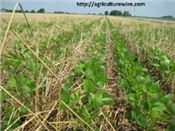|
Pest Management And Cover Crops
DR. SCOTT STEWART
JACKSON, TENN.
There is growing discussion and interest in the use of cover crops, mostly commonly in soybean but also in corn and cotton. Some of the benefits seem pretty intuitive and include improved control of erosion and the buildup of organic matter. Another obvious benefit is NRCS programs which pay growers to plant specified cover crops. Dr. Larry Steckel and his students have also shown benefits of cover crops in reducing the emergence of Palmer pigweed and some other weeds. However, having said all that, there are some concerns and unknowns about how cover crops might affect populations of soil and seedling pests.
A long-standing recommendation in the entomology arena has been to plant to a weed-free seed bed. In other words, avoid a “green bridge” that allows pests to move from weeds or cover crops directly into the crop. Experience has taught us that allowing green vegetation to persist in a field within a few weeks of planting can increase the risk to certain pest problems. Thus, we need to adjust our pest management practices to avoid crop losses when cover crops are used. The system and goal of planting the cover crop will affect your risks considerably. What problems you might see will depend on what cover-crop species are being planted and when the cover is terminated.
We don’t know as much as we should. In cotton, increasing ground residue has the benefit of reducing thrips injury and sand blasting. On the flip side, below are some examples of pest problems that myself, my colleagues, or growers have reported when using cover crops (and particularly when the cover crop was not terminated well in advance of planting). We’ve also observed an increased incidence of seedling diseases in some fields where cover crops were used.
• Slugs: These slimy plant feeders may occur in any crop, and are often worse in no-till situations with high crop residues.
• Threecornered alfalfa hopper: Dr. Larry Steckel has observed issues on seedling soybean when planting into a cover crop containing vetch (another host for this insect).
• The “pea weevil”: This little beetle can gnaw seedling soybean plants to the ground behind a cover crop of Austrian winter pea or vetch.
• Spider mites: They can jump from cover vegetative into the crop. We see this even with typical winter weeds like henbit when the burndown herbicides are applied too late or were not completely effective.
• Stink bugs: My counterpart in Arkansas, Dr. Gus Lorenz, has observed severe damage in seedling corn from stink bugs that were attracted to Austrian winter peas used in a cover crop.
The moral of this story … there are almost always pros and cons of changing your production system. There are a few things I suggest to help maximize the benefits of cover crops and reduce the risk of pest problems. These suggestions are more important as the cover crop is allowed to persist closer and closer to the planting window.
• Don’t use a cover crop on every acre. Place covers where the benefits are highest (e.g., biggest need for weed control, in fields at high risk to erosion, etc.). Get your feet wet first!
• Destroying the cover three or four weeks in advance of planting allows some insects to “starve out” or leave prior to planting. But this may not be compatible with the goal of your cover (for example, obtaining maximum ground cover for weed control).
• Avoid matching the crop. This also may not be practical, but as an example, planting a legume cover crop in front of another legume (like soybean) seems like a good way to attract critters that eat legumes.
• Can you use row cleaners or tillage? This can help with slugs by getting debris away from emerging seedlings. Row cleaners may become clogged with the cover residue. Of course, tillage, is not an option on erodible soils or necessarily compatible with your goals of using a cover crop.
• Are you using insecticide seed treatments? That’s pretty much a sure bet in corn and cotton, but I would strongly consider using an insecticide seed treatment in soybean behind a cover crop (especially one that contains vetch, Austrian winter peas, or some other legume).
• In corn, consider using the higher seed treatment rates or supplementing the base seed treatments with an in-furrow insecticide application. For those using pop-up fertilizers, an inexpensive option is to include one of several pyrethroid insecticides such as bifenthrin (Brigade, Capture LFR) or lambda-cyhalothrin (Warrior, etc.).
• Consider a broadcast spray of insecticide when terminating the cover crop. Again, pyrethroid insecticides are generally effective and inexpensive options that can control cutworms, threecornered alfalfa hoppers, and some other pests (but they will not affect larvae or grubs in the soil).
• Be especially vigilant in your scouting efforts during stand establishment, and manage your crop accordingly. ∆
DR. SCOTT STEWART: IPM Extension Specialist, University of Tennessee

|
|